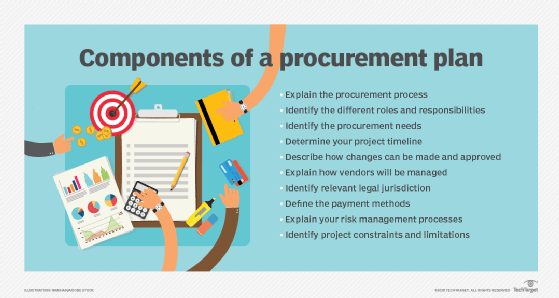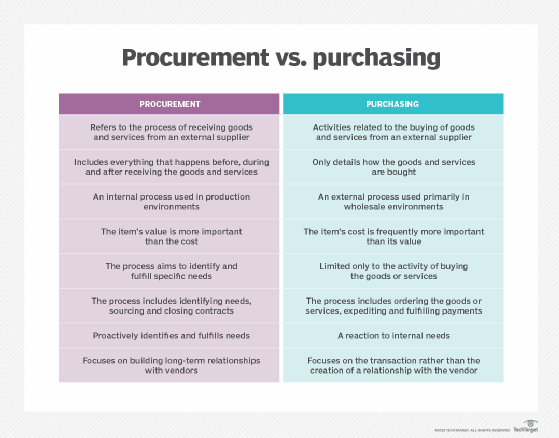What is a procurement plan?
A procurement plan -- also called a procurement management plan -- is a document that is used to manage the process of finding and selecting a vendor. The plan justifies the need for an external supplier and explains how the process of finding a supplier will be performed, from identifying the project requirements to closing the contract.
The goal of a procurement plan is to increase the efficiency, effectiveness and transparency of the procurement process. The document specifically describes how products or services will be acquired and how vendors will be managed during the project.
It includes information such as the types of contracts that will be used, the planned delivery or implementation dates for the contracted products or services, the types of metrics that will be used to evaluate the vendor's performance, and an explanation of how the procurement process will be performed.
Creating a procurement plan helps an organization avoid surprises and last-minute considerations. The document helps leaders decide what to buy, when to buy it and what sources to purchase from. A procurement plan also lets project planners determine if their expectations and requirements are realistic, as well as if the plan can be completed in the proposed project timeline.
Many companies use procurement software to automate and accelerate the procurement processes and optimize their workflow.
Key components of a procurement plan
Procurement plans can be created for specific technical requirements and projects or for multiple requirements related to different systems. While the details will vary, successful procurement plans will include the following components:
- The contract type to be used in the deal.
- An explanation of the metrics that will be used to judge the supplier's performance.
- Planned delivery or implementation dates for the products or services being provided.
- Identification of the organizational standards that must be complied with.
- The number of suppliers that will be involved and an explanation of how they will be managed.
- An explanation of how acquiring the new products or services will affect the constraints and limitations of the project plan.
- An alignment of lead times with the project schedule.
- If known, identification of all vendors who have been prequalified for the project.

How to write a procurement plan
The steps to create an effective procurement plan include the following:
Explain the procurement process. This section of the procurement plan provides an overview of the steps that must be taken to acquire products or services from a supplier as well as an explanation of what must be done to manage the process.
Identify roles and responsibilities. This section of the procurement plan identifies the different people working on the project and all stakeholders who will be affected by the project. The different roles involved in the procurement process include the following:
- Project managers who monitor the process and control the budget, schedule and project risks.
- Technical managers who create the statement of work (SOW) and oversee the technical requirements of the vendors.
- Contract managers who provide advice and documentation related to the project's contract requirements.
- C-level executives who provide contractual advice and make decisions related to the contracts. C-level execs are also responsible for reviewing and approving the final contract agreements.
- Lawyers who help with the creation of the contracts and provide advice for any related legal requirements.
Identify the procurement needs and requirements. The first section of the procurement plan describes the products or services the organization is looking to acquire. It offers an explanation and justification for why the products or services must be bought from an external supplier instead of internally sourced.
Define the project timeline. This section proposes a timeline for the project and describes the timeframe in which the products or services are needed. Including this section helps project teams better understand when the procurement process should be started and when it needs to be completed by.
Define change approval processes. This section describes the company's change management processes -- specifically, how changes can be made to the procurement process and documentation. The section includes an explanation of how to ensure the changes are necessary, understood and approved by all appropriate people.
Identify vendor management techniques. This section of the procurement plan explains the techniques that will be used to manage vendors once they have signed the contract. The goal of this section is to ensure vendors fulfill their side of the deal and provide the organization with the products or services they've requested at the quality they expect. Vendor management techniques include the following:
- Detailing vendor selection criteria based on cost and risk analysis.
- Creating a SOW that outlines the project timeline, deadlines and compliance requirements.
- Using key performance indicators (KPIs) to measure the product or service quality.
- Conducting regular project meetings.
- Requiring the vendor to provide the project owner with regular project updates.
Define relevant legal jurisdiction. All legal requirements for the project should be identified to ensure the company and vendor comply with the laws. For example, companies need to consider if they are affected by legislation such as the California Consumer Privacy Act or General Data Protection Regulation and whether the product or service they are considering offers regulatory compliance with the relevant laws. The legal requirements should also be clearly identified to ensure all stakeholders are aware of them and do not violate the legislation.
Identify payment methods. This section identifies the different payment methods and currencies that will be used and accepted during the procurement process. If payments are to be made periodically -- such as monthly or annually -- then the terms for these payments must be detailed to ensure there is no conflict between the organization and vendor regarding how much money is owed.
Explain risk management processes. Working with an external supplier introduces new risks to a project that would not be relevant if the project was internally sourced. This section of the procurement plan details the risk profile of the project, including the following:
- Risk tolerance.
- Risk probability.
- Risk severity.
- Types of contracts used.
- Policies and procedures outlined in the contracts.
- Review and approval processes for requirements.
The statement of work is an essential element of a company's risk management processes. The SOW defines the necessary project activities, deliverables and timelines that the vendor must follow to fulfill their half of the deal. Providing vendors with a SOW reduces risk by ensuring the supplier knows exactly what is expected of them and when it is expected.
Identify project constraints and limitations. This section of the procurement plan explains all the constraints and limitations that the project team and vendor must deal with. This can include the following:
- Scheduling limitations.
- Legal compliance.
- Budget restrictions.
- External stakeholders.
- Geographic restrictions.
- Security requirements.
- Standards and specifications.
Benefits of procurement planning
Procurement plans provide many benefits to organizations that are looking to acquire new products or services from external suppliers. Most notable is the document's help with the management of the procurement process. Other benefits include the following:
- Procurement planning increases the transparency and predictability of the procurement process.
- Procurement planning helps companies collect similar requirements under one contract as well as divide complex requirements into multiple contract packages to maximize cost savings.
- Procurement planning lets organizations determine any additional staffing needs upfront, including external assistance that might be necessary to set up the products or services.
- Procurement planning allows companies to compare real-world performance with the planned project activities and timeline and alert departments to adjust processes that are off track.
- Procurement planning provides an opportunity for all stakeholders to meet and discuss the requirements they feel are needed.
- Procurement planning lets organizations estimate how much time will be required to complete the procurement process and close contracts.
Examples of procurement software
Procurement software is a computer program or suite that automates the purchasing and inventory recording processes. Using procurement software, companies can create purchase orders, pay bills, execute online ordering processes and match invoices to the materials that have been received.
Procurement software is grouped into four major categories:
- Procure to pay (P2P) software, which manages the process of requisitioning, purchasing, receiving, paying for and accounting for goods and services.
- Purchasing software, which streamlines the last half of the procurement process by automating the steps of the purchasing cycle and linking purchasing functions with accounting functions.
- Request for proposal (RFP) software, which helps organizations with the creation and management of RFP documents.
- Spend analysis software, which helps companies collect, categorize and evaluate expenditure data.

Some of the top P2P software options include the following:
- SAP Ariba.
- Varis.
- Precoro.
- Coupa.
Other offerings include Emburse Professional and ProcurementExpress.com.
Popular RFP software options include the following:
- Responsive.
- Qvidian.
- RocketDocs.
- Loopio.
- QorusDocs.
Finally, some of the top spend analysis software options include the following:
- AppZen Expense Audit.
- GEP Smart.
- Coupa Spend Analysis.
- Oversight Spend Monitoring.
- Xeeva.
- SpendHQ.





